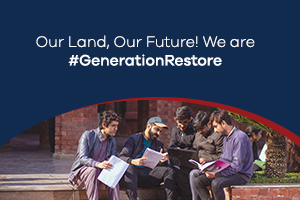Our Land, Our Future! We are #GenerationRestore

Every year, June 5th is observed as World Environment Day. WED is observed for sustainability and to restore the environment. This year, the 5th of June 2024 is hosted by the Kingdom of Saudi Arabia. This year’s focus is on restoring our primary asset- Land! Let’s explore more!
World Environment Day 2024
Following the international tradition of working for the environmental sustainability of the ecosystem, Saudi Arabia is taking the lead in 2024 and hosting World Environment Day 2024 with a theme of ‘Land Restoration, Desertification, And Draught Resilience.’
Countries are committed to restoring 1 billion hectares of degraded land, reversing the loss in nature, and making this place more livable for living beings.
Saudi Arabia is standing among the nations embracing the process of restoration. The nation’s efforts to reintroduce animals into the wild are proceeding alongside initiatives to rehabilitate 200 million hectares of degraded land domestically and internationally.
Saudi Arabia is also striving to achieve its nature conservation objectives as outlined in its Vision 2030. The nation has expanded protections to cover over 18 percent of its land, a significant increase from the previous 4 percent. Furthermore, it has bolstered its collection of national parks to over 400, a substantial growth from the initial 19 parks.
Moreover, Vision 2030 is a third pillar of environmental sustainability with an economic and social development window. It has a high level of emphasis and focus. Saudi Arabia is working closely with international bodies.
For instance, the National Center for Vegetation Cover Development and Combating Desertification. is working on the restoration of land for wildlife, which hopefully would be helpful for the rehabilitation of rare and endangered species like Arabian Leopard.
World Environment Day, also known as (WED 2024), is all about the following.
Highlighting the pressing issue: Land degradation and desertification pose significant threats to food security and biodiversity and accelerate climate change, necessitating awareness and action.
Urgent action amid the triple planetary crisis: Climate Change, Nature and Biodiversity Loss, and Pollution and Waste intensify, calling for immediate measures.
Emphasising collective responsibility: Restoring our planet’s ecosystems demands collective action and individual commitment, urging everyone to contribute to solutions.
Empowering the youth: The 2024 slogan’s #GenerationRestoration underscores the pivotal role of young people in spearheading sustainable change, motivating them to take proactive steps.
In alignment with global objectives: The theme for World Environment Day 2024 resonates with the UN Decade on Ecosystem Restoration (2021-2030) and Sustainable Development Goals, advocating for a comprehensive approach to environmental preservation.
Explore Some Facts About Terrestrial Eco Systems
‘Terrestrial Ecosystems’ are land-based communities or organisms with diverse biotic and abiotic interactions. Tropical forests, grasslands, and deserts are some examples of Terrestrial Ecosystems.
In the following text, you will see some of the inspiring facts about these land-based Terrestrial Ecosystems.
Soil and Water
The land is the most biodiverse habitat on our planet, as 60% of the species live in soil.
An immense amount of carbon is stored in healthy soils, which can cause a huge spike in planetary warming if released.
Climate Change is heinously threatening the useable and freshwater supply. Today, only 0.5 percent of healthy water is available.
Soil moisture, snow, and ice are the land-based water storage elements. In the past twenty years, we have lost one centimeter (about 0.39 in) per year, resulting in serious water ramifications for water security and food production.
Dry Lands
Drylands are the areas with massive water scarcity. These lands cover around 41% of the earth’s land surface and more than 75% of the world’s range lands.
Around 44 % of crops are generation of dry lands globally. Ultimately, it supports around 2 billion people and feeds half of the global lifestock.
Moreover, drylands are the home of 1/4 of the world’s forests. It calculates the third of the global biodiversity and migration points for birds.
Deserts
Deserts are present on every continent, and they cover one-fifth of the earth’s land.
The Sahara Desert, the largest hot desert in the world, is home to 500 plant species, 70 mammal species, 100 reptilian species, and 90 avian species.
Climate change is expanding the presence of deserts. However, more than 22 countries are combating this disastrous change. Hence, the Great Green Wall initiative was adopted, which aimed to restore 100 hectares of land through productive landscapes.
The other examples of terrestrial ecosystems are forests, fresh water, farmlands, and cities.
What Can You Do?
Land restoration requires diverse approaches on various levels. From international efforts to domestic try, everything counts! These can include actions such as planting native plants, practicing sustainable land management, creating protected zones, and embracing agroforestry systems to revive soil health and productivity. You can also follow the UCP’s Climate Change Research Centre Newsletter
Signing Off
Observe World Environment Day 2024 with proper thought management to work for the land and environment to the best of your capacity. Arrange awareness sessions, seminars, and discussions to safeguard your earth’s largest habitat—land!
